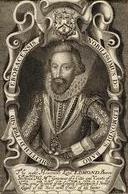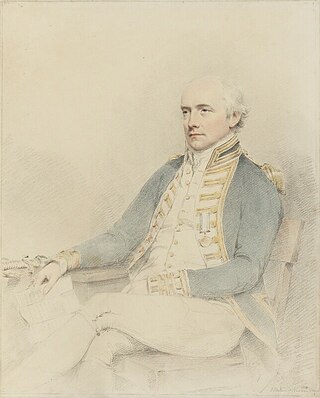A victory title is an honorific title adopted by a successful military commander to commemorate his defeat of an enemy nation. The practice is first known in Ancient Rome and is still most commonly associated with the Romans, but it was also adopted as a practice by many later empires, especially the French, British and Russian Empires.

Viscount Cobham is a title in the Peerage of Great Britain that was created in 1718. Owing to its special remainder, the title has passed through several families. Since 1889, it has been held by members of the Lyttelton family.

General Henry Phipps, 1st Earl of Mulgrave,, styled The Honourable Henry Phipps until 1792 and known as The Lord Mulgrave from 1792 to 1812, was a British soldier and politician. He notably served as Foreign Secretary under William Pitt the Younger from 1805 to 1806.

The title Earl of Mulgrave has been created twice. The first time as a title in the Peerage of England and the second time as a Peerage of the United Kingdom.

Earl of Powis (Powys) is a title that has been created three times. The first creation came in the Peerage of England in 1674 in favour of William Herbert, 3rd Baron Powis, a descendant of William Herbert, 1st Earl of Pembroke. In 1687, he was further honoured when he was made Marquess of Powis.

Earl Nelson, of Trafalgar and of Merton in the County of Surrey, is a title in the Peerage of the United Kingdom. It was created on 20 November 1805 for the Rev. William Nelson, 2nd Baron Nelson, one month after the death of his younger brother Vice-Admiral Horatio Nelson, 1st Viscount Nelson, the famous naval hero of the Napoleonic Wars and victor of the Battle of Trafalgar of 21 October 1805. The title is extant, the present holder being Simon Nelson, 10th Earl Nelson, who has an heir apparent. The family seat of Trafalgar House in Wiltshire was sold in 1948 by Edward Nelson, 5th Earl Nelson.

Earl of Lonsdale is a title that has been created twice in British history, firstly in the Peerage of Great Britain in 1784, and then in the Peerage of the United Kingdom in 1807, both times for members of the Lowther family.

Earl of Gainsborough is a title that has been created twice, once in the Peerage of England and once in the Peerage of the United Kingdom. The first creation ended in extinction when the sixth Earl died without heirs. However, the title was revived in 1841 for a female-line relative.

Earl of Eldon, in the County Palatine of Durham, is a title in the Peerage of the United Kingdom. It was created in 1821 for the lawyer and politician John Scott, 1st Baron Eldon, Lord Chancellor from 1801 to 1806 and again from 1807 to 1827. He had already been created Baron Eldon, of Eldon in the County Palatine of Durham, in the Peerage of Great Britain in 1799, and was made Viscount Encombe, of Encombe in the County of Dorset, at the same time was given the earldom. His grandson, the second Earl, briefly represented Truro in the House of Commons.

Baron Manners, of Foston in the County of Lincoln, is a title in the Peerage of the United Kingdom. It was created in 1807 for the lawyer and politician Sir Thomas Manners-Sutton. He served as Solicitor-General from 1802 to 1805 and as Lord Chancellor of Ireland from 1807 to 1827. Manners-Sutton was the fifth son of Lord George Manners-Sutton, third son of John Manners, 3rd Duke of Rutland. His elder brother Charles Manners-Sutton was Archbishop of Canterbury from 1805 to 1828 and the father of Charles Manners-Sutton, 1st Viscount Canterbury, Speaker of the House of Commons from 1817 to 1834. The first Baron's great-grandson, the fourth Baron, assumed the surname of Manners only. As of 2010 the title is held by the latter's grandson, the sixth Baron, who succeeded his father in 2008.

Viscount Buckmaster, of Cheddington in the County of Buckingham, is a title in the Peerage of the United Kingdom. It was created in 1933 for the lawyer and Liberal politician and former Lord Chancellor, Stanley Buckmaster, 1st Baron Buckmaster. He had already been created Baron Buckmaster, of Cheddington in the County of Buckingham, in 1915, also in the Peerage of the United Kingdom. His grandson, the third Viscount Buckmaster left school to join the British military's Royal Sussex Regiment branch during World War II. In 1940 he received commission and served in the Middle East, he subsequently was granted and honorary rank of Captain, he moved on to new roles in government from 1953. The viscount was appointed an Officer of the Order of the British Empire (OBE) in the 1979 Birthday Honours and was a diplomat working in the foreign office between 1946-1981 working in the middle east and Africa. As of 2017 the titles are held by the latter's nephew, the fourth Viscount, who succeeded in 2007.

Admiral of the Fleet James Gambier, 1st Baron Gambier, was a Royal Navy officer. After seeing action at the capture of Charleston during the American Revolutionary War, he saw action again, as captain of the third-rate HMS Defence, at the battle of the Glorious First of June in 1794, during the French Revolutionary Wars, gaining the distinction of commanding the first ship to break through the enemy line.

Gerard Lake, 1st Viscount Lake was a British general. He commanded British forces during the Irish Rebellion of 1798 and later served as Commander-in-Chief of the military in British India.

William Willoughby Cole, 1st Earl of Enniskillen, styled The Honourable from 1760 to 1767, then known as the Lord Mountflorence to 1776 and as the Viscount Enniskillen to 1789, was an Irish peer and politician.

HMS Gladiator was a 44-gun fifth-rate Roebuck-class ship of the Royal Navy. She was launched on 20 January 1783 by Henry Adams of Bucklers Hard. She spent her entire career on harbour service, never putting to sea. Even so, her crew earned prize money for the seizure of two Russian and five American ships. Her sessile existence made her an excellent venue for courts-martial and a number of notable ones took place aboard her. She was broken up in 1817.

Admiral George Stewart, 8th Earl of Galloway,, styled Lord Garlies between 1773 and 1806, was a British naval commander and politician.
Vice-Admiral the Hon. Charles Orlando Bridgeman was a Royal Navy officer who saw active service in the Napoleonic Wars and the Greek War of Independence.
The Honourable George Augustus Frederick Lake (1781-1808) was a British Army Commanding Infantry Officer who Commanded His Majesty's 29th Regiment of Foot during the early stages Peninsular War.
Clotworthy Upton (1768–1822) was an officer in the Royal Navy who served during the French Revolutionary and Napoleonic Wars. He was the illegitimate son of Clotworthy Upton, 1st Baron Templetown. Upton joined the service at the age of eleven, as a captain's servant aboard HMS Alexander. Despite passing his lieutenant's examination in 1790, he could not obtain a position in the Royal Navy and sought employment in the merchant fleet in 1791. Upton returned to military service in January 1801, when he was appointed Master and Commander of HMS Zephyr. It was in her that Upton fought at the Battle of Copenhagen in 1801.











